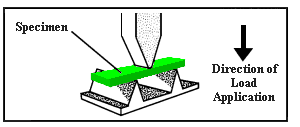Flexural Strength Testing of Plastics
The flexural strength of a material is defined as its ability to resist deformation under load. For materials that deform significantly but do not break, the load at yield, typically measured at 5% deformation/strain of the outer surface, is reported as the flexural strength or flexural yield strength. The test beam is under compressive stress at the concave surface and tensile stress at the convex surface. The figure below, from Mitsubishi Chemical Advanced Materials, shows the test geometry for ASTM D790.
 ASTM D790:
Specimen of 1/8" x 1/2" x 5" is placed on two supports and a load is applied at the center. The load at yield is the sample material's flexural strength.
ASTM D790:
Specimen of 1/8" x 1/2" x 5" is placed on two supports and a load is applied at the center. The load at yield is the sample material's flexural strength.
The analogous test to measure flexural strength in the ISO system is ISO 178. The values reported in the ASTM D790 and ISO 178 tests seldom differ significantly enough to matter in the early stages of materials selection. These tests also give the procedure to measure a material's flexural modulus (the ratio of stress to strain in flexural deformation).
The table below lists average flexural strengths and flexural moduli values for some filled and unfilled polymers. These values are a measure of stiffness; flexible materials such as elastomers have lower values than fiber reinforced engineering polymers used as metal substitutes such as polyimides or acetals.
Typical Flexural Strength and Flexural Modulus of Polymers
